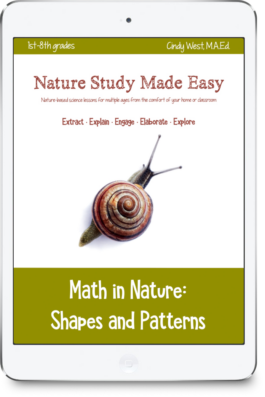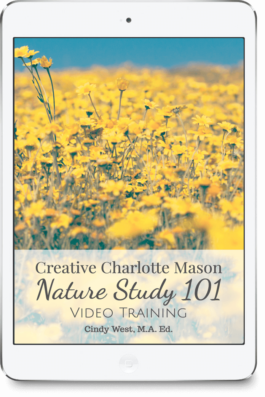In-Depth Nature Study for a High School Student
Nature study doesn’t have to stop once high school rolls around!
In fact, we’re enjoying it with more depth than we ever have before. Simply think of nature study as one of the most perfect “labs” available for experiencing and understanding high school science concepts.
Take last week for example…We’ve been learning about the plant kingdom. After studying throughout the week about vascular/non-vascular plants, seedless vascular/gymnosperms/angiosperms, and monocots and dicots, we set out Friday to find some real-life examples of each.
I had the kids create a notebooking page “in the field”.

Nothing fancy. Just a chart of the various things we were hoping to find and a place for notes when we did find them.
Monocots and Dicots
Since we live in a part of the U.S. considered the deciduous forest zone, finding ferns and conifers is not easy on our farm. As you can see from the notebooking page, we spent most of our time discovering monocot and dicot angiosperms. So, that’s what I’ll focus on as I demonstrate how our book work turned into real life during our weekly nature walk.
Angiosperms are seed-bearing plants in which the seed is encompassed in a fruit. Whether they are monocots or dicots is determined by the number of cotyledons inside the seed. (The little tiny leaves present when you open the seed – think about the bean seed you’ve soaked and opened with your kids in the past. Everybody’s done that before, right?) Monocots have one little leaf inside the seed, while dicots have two.
You can’t always easily open a seed to find the cotyledons, so other clues are present to help you place a plant in the correct category. Monocots typically have parallel veins in their leaves and their flower petals are in 3’s (3, 6, 9…). Dicots typically have webbed veins in their leaves and flower petals come in 4’s or 5’s (4, 8, 12…5, 10, 15…)
Using that information, here’s a sampling of some of the plants we found and documented.
Monocots

Asiatic Dayflower – 3 petals, parallel veined leaves

Unidentified – Beautiful! Parallel veined leaves

Foxtail Grass – parallel veined leaves

Corn – parallel veined leaves
Dicots

Chickory – 15 petals (I know, 15 is a monocot clue, too. I checked the internet to be sure it fits as a dicot.)

Tomato – webbed leaf veins, 5 petals

Unidentified – webbed leaf veins, 5 petals

Red oak tree with developing acorn – webbed leaf veins

Common sow thistle – webbed leaf veins
Extras

We hadn’t intended to study seedless non-vascular mosses, but this one was too pretty to pass over.

Earlier in the week, we had learned about the xylem cells which take water and nutrients from the roots to the rest of the tree, and the phloem cells which deliver the “food” back down through all the parts of the tree. The book we were studying mentioned that the cambium, located just under the bark of the tree, makes these cells. If a tree is “girdled” (or the cambium disturbed all the way around a tree), the tree will not be able to survive because xylem and phloem cells won’t be produced. We just “happened” to come across this tree that seems as if it’s been girdled (likely by a rabbit). Since the girdling is fresh, the tree is healthy, but we have plans to keep our eye on it over the next few months for signs of death. God’s pretty cool to set before us something we hadn’t even intended to find!
NaturExplorers
So many people tell me they don’t really know where to start with nature study – especially connecting it to “regular” science studies – that I want to make sure you know there are tools out there. Even though the NaturExplorers studies were written with the 1st-8th grader in mind, they are very adaptable and even include high school extension ideas. The above lesson is not included in any of the studies, but it’s an example of how deep nature study really can go!

I offer several botany-themed studies:
More About Incorporating Nature Study:
-
Math in Nature$18.00
-
-
I’d love to hear about YOUR nature studies with high school students!
This post has been linked to:







what a great post.
I don’t have a high school student yet:)
But, I have been writing a post to come out tomorrow on how to enjoy nature study and I’ve pondered some thoughts about nature study with teens and how important “I” think it is.
It’s good to see mothers engaging with older children in nature study!!!
So many great ideas for nature studies. It inpires me to get outside!
This is great! My freshman is doing Abeka Biology and this goes right along with what we are doing. I will be following!
We like to use our time out in nature for appreciation of God’s beautiful world….but I loved reading your botany study. Mine is studying physics this year, so her labs are on that at this time.
Hi Betsy,
It’s Jackie stopping by from the March Let’s Homeschool High School Blog Hop. What great pics! Hands-on learning is so much fun and sticks with the kids. Great job.
I look forward to your blog post in the April HSHS Blog Hop.
Joyfully,
Jackie
Let’s Homeschool High School Admin